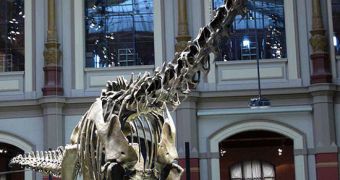Dinosaurs dominated the Earth, totally or partially, for at least 160 million years before the K-T (Cretaceous–Tertiary) extinction event, which saw the disappearance of the giant lizards. The earliest of these animals were small, two-legged creatures, but some of their predecessors grew to enormous sizes, and walked on all fours. How these immense herbivores, known as sauropods, evolved was still a mystery until recently, when a newly-discovered fossil threw a new light on the links between the early and late dinosaurs, the BBC News reports.
The new skeleton, which is of a creature that walked on two legs, but could walk on all fours as well, is remarkably well preserved, and it allowed scientists to determine that it represents the missing link between the two types or reptiles. Details of the amazing discovery have been published in the latest issue of the respected scientific journal Proceedings of the Royal Society B. The fossils were unearthed at a location in the Senekal district of South Africa.
“What we have is a big, short-footed, barrel-chested, long-necked, small-headed dinosaur. The earliest ancestral dinosaur – the great grand-daddy of all dinosaurs – walked on two legs. This [one] is intermediate between those bipedal forms and the true gigantic sauropods,” University of Witwatersrand in Johannesburg scientist Adam Yates says. The expert was also the leader of the new research. The slow-moving animal was named Aardonyx celestae, and is estimated that it lived more than 200 million years ago.
“It had a lot of features we see on sauropods. Short, broad feet and a big, broad gut, so it was clearly a plant-eater that was bulk-feeding. And the anatomy of the jaw shows it had a wide gape – to stuff more food in. Its toe bones were very robust and solid, so its weight was being born on the inside of the foot. It was still bipedal, but it may have been going down on to all fours to browse,” Yates adds. “Although structurally it's intermediate, it lived too late to be an actual ancestor, because true sauropods already existed [then]. So, at the time, it was a living fossil – the transition must have happened much earlier.

 14 DAY TRIAL //
14 DAY TRIAL //